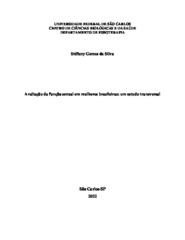| dc.contributor.author | Silva, Stéfany Gomes da | |
| dc.date.accessioned | 2023-04-25T14:01:24Z | |
| dc.date.available | 2023-04-25T14:01:24Z | |
| dc.date.issued | 2022-10 | |
| dc.identifier.citation | SILVA, Stéfany Gomes da. Avaliação da função sexual em mulheres brasileiras: um estudo transversal. 2022. Trabalho de Conclusão de Curso (Graduação em Fisioterapia) – Universidade Federal de São Carlos, São Carlos, 2022. Disponível em: https://repositorio.ufscar.br/handle/ufscar/17864. | * |
| dc.identifier.uri | https://repositorio.ufscar.br/handle/ufscar/17864 | |
| dc.description.abstract | Introduction: The physiological female sexual response is mediated by multiple components that, when impaired, can trigger sexual dysfunction (SD) in this population. SD causes negative impacts on women's quality of life and, although the study on the subject is growing, its prevalence is still growing year by year and information on sexual function in Brazilian women is scarce. Objectives: To evaluate sexual function in Brazilian women and to investigate the prevalence and factors associated with the presence of female sexual dysfunction (FSD)
in this population. Methods: The present study used the Female Sexual Function Index (FSFI) questionnaire as a basis for DSF screening, which assesses sexual response based on desire, arousal, vaginal lubrication, sexual satisfaction, orgasm and pain. the questionnaire
was made available online and could be answered by women aged 18 years or older and with an active sex life, characterized by sexual activity present within the four weeks prior to participation. Scores <26.55 on the FSFI were considered as the presence of DSF. From
In addition, women were divided into two groups, with and without DSF. Comparison between groups was performed using demographic characteristics with the t test for independent samples (continuous variables with normal distribution), the Mann-Whitney test (continuous variables without
normal distribution) and the chi-square test (categorical variables). The association between the patient's characteristics and the FSD was based on binomial logistic regression. Results: 621 women participated in the study; the average age of participants was 29.8 (8.9%) years, 274 (44.1%) were married and 305 (49.1%) had higher education. About 31.7% (95% CI = 28.2% – 35.5%) had sexual dysfunction based on the FSFI score. The logistic regression performed showed the practice of physical activity as inversely associated with FSD (OR=0.65; CI 0.45 – 0.92), while urinary incontinence (OR=2.21; CI 1.55 – 3, 16) and menopause increase (OR=4.60; CI 1.62 – 13.1) by 2.2 and 4.6 times, respectively, the chance of occurrence of SD. Conclusion: It is believed that menopause and UI are phenomena that contribute to the development of FSD in Brazilian women, while the practice of physical activity reduces the chances of this dysfunction. | eng |
| dc.description.sponsorship | Não recebi financiamento | por |
| dc.language.iso | por | por |
| dc.publisher | Universidade Federal de São Carlos | por |
| dc.rights | Attribution-NonCommercial-NoDerivs 3.0 Brazil | * |
| dc.rights.uri | http://creativecommons.org/licenses/by-nc-nd/3.0/br/ | * |
| dc.subject | Disfunções sexuais fisiológicas | por |
| dc.subject | Sexualidade | por |
| dc.subject | Prevalência | por |
| dc.subject | Saúde da mulher | por |
| dc.title | Avaliação da função sexual em mulheres brasileiras: um estudo transversal | por |
| dc.title.alternative | Evaluation of sexual function in Brazilian women: a cross-sectional study | eng |
| dc.type | TCC | por |
| dc.contributor.advisor1 | Beleza, Ana Carolina Sartorato | |
| dc.contributor.advisor1Lattes | http://lattes.cnpq.br/4139635204538357 | por |
| dc.contributor.advisor-co1 | Fabricio, Amanda Magdalena Feroldi | |
| dc.contributor.advisor-co1Lattes | http://lattes.cnpq.br/4902153667074796 | por |
| dc.description.resumo | Introdução: A resposta sexual feminina fisiológica é mediada por múltiplos componentes que, quando prejudicados, podem desencadear a disfunção sexual (DS) nessa população. A DS causa impactos negativos na qualidade de vida da mulher e, muito embora o estudo sobre o tema esteja em crescimento, sua prevalência ainda cresce ano e ano e são escassas as informações sobrea função sexual em mulheres brasileiras. Objetivos: Avaliar a função sexual em mulheres brasileiras e investigar a prevalência e os fatores associados à presença de disfunção sexual feminina (DSF)
nessa população. Métodos: O presente estudo utilizou como base para o rastreio da DSF o questionário Female Sexual Function Index (FSFI), que avalia a resposta sexual com base nos domínios desejo, excitação, lubrificação vaginal, satisfação sexual, orgasmo e dor. O questionário
foi disponibilizado on-line e pôde ser respondido por mulheres com 18 anos ou mais e com vida sexual ativa, caracterizada por atividade sexual presente dentro das quatro semanas anteriores à participação. Foram consideradas pontuações <26.55 no FSFI como presença de DSF. A partir
disso, as mulheres foram divididas em dois grupos, com e sem DSF. A comparação entre grupos foi feita por meio das características demográficas com teste t para amostras independentes (variáveis contínuas com distribuição normal), teste de Mann-Whitney (variáveis contínuas sem
distribuição normal) e o teste Qui-quadrado (variáveis categóricas). Já a associação entre as características do paciente e a DSF foi feita com base na regressão logística binominal. Resultados: Participaram do estudo 621 mulheres; a média de idade das participantes foi de 29,8 (8,9%) anos, 274 (44,1%) possuíam vida conjugal e 305 (49,1%) tinham ensino superior . Cerca de 31,7% (IC 95% = 28,2% – 35,5%) apresentaram disfunção sexual com base no escore do FSFI. A regressão logística realizada apontou a prática de atividade física como inversamente associada à DSF (OR=0,65; IC 0,45 – 0,92), enquanto a incontinência urinária (OR=2,21; IC 1,55 – 3,16) e a menopausa aumentam (OR=4,60; IC 1,62 – 13,1) em 2,2 e 4,6 vezes, respectivamente, a chance de ocorrência de DS. Conclusão: Acredita-se que a menopausa e a IU são fenômenos que colaboram para com o desenvolvimento de DSF em mulheres brasileiras enquanto a prática de atividade física diminui as chances dessa disfunção. | por |
| dc.publisher.initials | UFSCar | por |
| dc.subject.cnpq | CIENCIAS DA SAUDE | por |
| dc.publisher.address | Câmpus São Carlos | por |
| dc.publisher.course | Fisioterapia - Fisio | por |

